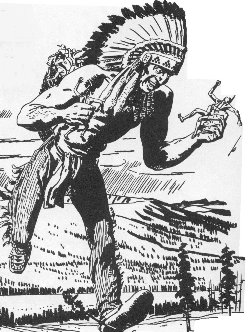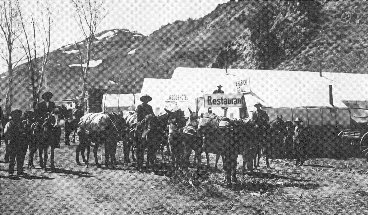|
[Index] How a Gold Rush Begins
Jarbidge, Nevada - 1909
Tsaw-haw-bitts is not listed on maps. When the prospectors began their rush into the canyon, the name was changed. From Tsaw-haw-bitts it somehow became Jahabich then was bastardized to Jarbidge along the way. There is a strange tale from 1883 about sheep camp tender George Ishman. He gave a chunk of ore he found in the canyon to his boss, John Pence, of Salt Lake City, who had it assayed. Its value was $1,200 per ton. That was better than good, it was great. By then, Ishman had sickened, became paralyzed and couldn't talk. Pence was so desperate to know from where the gold came that he hired mediums hoping they could read the sick man's mind. They failed. This is just one of the stories about the "Lost Sheepherder Mine." The legend still lives although some people, over the decades, say it was found while others maintained it wasn't. So, who knows? Not much happened in the in the canyon until David S. Bourne came to the place in 1909 and began sluicing gravel on a creek. He followed streaks of color up to an outcropping containing very rich gold ore. He called his first claim the North Star. His outcropping and another discovered by John Escalon were the only ledges found - all the other mining was by trenching and panning until large companies with money for underground mining and electric milling to economically produce gold. This is the usual procedure in any mining camp. Most of the time the prospector finds the ore then a big company buys him off with a meager payoff. That was okay with the discoverer. A few days or months of celebrating, then he wandered off looking for another strike. That's all he ever wanted to do anyway. Perhaps it is the overpowering urge to brag but all over the American West discoverers of gold and silver just couldn't keep their mouths shut. They spilled the beans and thousands of prospectors inundated new strikes. Bourne was no different. He was a blabber mouth. In February 1910, he was quoted in a Los Angeles newspaper as saying, "There are $27 million of gold ore in sight."
His big fib about the amount of gold was a huge exaggeration. This caused a stampede to the canyon. Within a few weeks there were 1,500 men in town, all hoping to strike it rich. When they saw the blatant overstatement, they packed up and left. In a few weeks only about four hundred remained. Fifty were working in the mines and others were out climbing the hills and rocks eagerly looking for gold. Only the big mines and mills made any money. The little guy just didn't have the cash to make his claim a success. In 1918 and 1919 the Jarbidge district was the biggest gold producer in Nevada then production tapered off and the town's population began to dwindle. Jarbidge is one of the most remote and beautiful old mining camps in Nevada. A few hardy souls live there all year but the place is pretty busy during the summer. The trip is worthwhile. Enjoy, but look over your shoulder - you might catch a glimpse of the Evil Giant. Source: "Letters From Jarbidge," by Howard Hickson, Northeastern Nevada Historical Society Quarterly, Spring 1978. Illustrations: Tsawhawbitts, Pioneer Nevada, Harolds Club, Reno, 1951; Jarbidge street scene, Northeastern Nevada Museum, Elko, archives. ©Copyright 2003 by Howard Hickson |
 It was spring,
1909, in the Canyon of the Evil Giant. Called Tsaw-haw-bitts, he was supposedly
the Devil who had been chased out of Owyhee by the people there. Indians
did not go into the canyon for fear of being captured and eaten. This legend
did not keep white prospectors out of the area. In their feverish pursuit
of gold they prospected just about anywhere they wanted.
It was spring,
1909, in the Canyon of the Evil Giant. Called Tsaw-haw-bitts, he was supposedly
the Devil who had been chased out of Owyhee by the people there. Indians
did not go into the canyon for fear of being captured and eaten. This legend
did not keep white prospectors out of the area. In their feverish pursuit
of gold they prospected just about anywhere they wanted.
